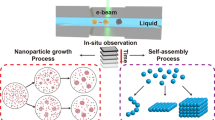Abstract
Two types of amorphous TiO2 particles with different particle sizes were synthesized by a simple sol–gel method and were characterized by X-ray diffraction analysis, field emission scanning electron microscopy, and Fourier transform infrared spectrometry. The electrorheological (ER) results show that the TiO2/silicone oil suspensions exhibited a remarkable ER effect. The static shear stress can be up to 130 kPa (shear rate 0.2 s − 1) under the DC electric field of 4 kV/mm at room temperature. The polar molecules present on the particles’ surface play a decisive role for the observed giant ER effect, which arises from the alignment of polar molecules in the gap between neighboring particles.







Similar content being viewed by others
References
Cao JG, Shen M, Zhou LW (2006) Preparation and electrorheological properties of triethanolamine-modified TiO2. J Solid State Chem 179:1565–1568
Cheng YC, Guo JJ, Xu GJ, Cui P, Liu XH, Liu FH, Wu JH (2008) Electrorheological property and microstructure of acetamide-modified TiO2 nanoparticles. Colloid Polym Sci 286:1493–1497
Cho MS, Choi HJ, To KW (1998) Effect of ionic pendent groups on a polyaniline-based electrorheological fluid. Macromol Rapid Commun 19:271–273
Choi HJ, Lee YH, Kim CA, Jhon MS (2000) Microencapsulated polyaniline particles for electrorheological materials. J Mater Sci Lett 19:533–535
Filisko FE, Radzilowski LH (1990) An intrinsic mechanism for the activity of aluminosilicate based electrorheological materials. J Rheol 34:539–552
Gamota DR, Filisko PE (1991) Dynamic mechanical studies of electrorheological materials-moderate frequencies. J Rheol 35:399–425
Gong XQ, Wu JB, Huang XX, Wen WJ, Sheng P (2008) Influence of liquid phase on nanoparticle-based giant electrorheological fluid. Nanotechnology 19:165602
Halsey TC (1992) Electrorheological fluids. Science 258:761–766
Hao T (2001) Electrorheological fluids. Adv Mater 13:1847–1857
Hao T (2002) Electrorheological suspensions. Adv Colloid Interface Sci 97:1–35
Ikazaki F, Kawai A, Uchida K, Kawakami T, Edamura K, Sakurai K, Anzai H, Asako Y (1998) Mechanisms of electrorheology: the effect of the dielectric property. J Phys D Appl Phys 31:336–347
Jun JB, Suh KD (2003) Preparation and electrorheological characterization of suspensions of poly(urethane acrylate)/clay nanocomposite particles. J Appl Polym Sci 90:458–464
Lu J, Zhao XP (2002) Electrorheological properties of a polyaniline-montmorillonite clay nanocomposite suspension. J Mater Chem 12:2603–2605
Lu KQ, Shen R, Wang XZ, Sun G, Wen WJ, Liu JX (2007) Polar molecule type electrorheological fluids. Int J Mod Phys B 28&29:4798–4805
Parthasarathy M, Klingenberg DJ (1996) Electrorheology: mechanisms and models. Mater Sci Eng R 17:57–103
Wang BX, Zhao XP, Zhao Y, Ding CL (2007a) Titanium oxide nanoparticle modified with chromium ion and its giant electrorheological activity. Compos Sci Technol 67:3031–3038
Wang BX, Zhao Y, Zhao XP (2007b) The wettability, size effect and electrorheological activity of modified titanium oxide nanoparticles. Colloids Surf A Physicochem Eng Asp 295:27–33
Wei C, Zhu YH, Jin Y, Yang XL, Li CZ (2008) Fabrication and characterization of mesoporous TiO2/polypyrrole-based nanocomposite for electrorheological fluid. Mater Res Bull 43:3263–3269
Wen WJ, Huang XX, Sheng P (2004) Particle size scaling of the giant electrorheological effect. Appl Phys Lett 85:299–301
Wen WJ, Huang XX, Sheng P (2008) Electrorheological fluids: structures and mechanisms. Soft Matter 4:200–210
Wen WJ, Huang XX, Yang SH, Ku KQ, Sheng P (2003) The giant electrorheological effect in suspensions of nanoparticles. Nat Mater 2:727–730
Wen WJ, Tam WY, Sheng P (1998) Fabrication of PZT microspheres for application in electrorheological fluids. J Mater Sci Lett 17:419–421
Winslow WM (1949) Induced fibration of suspensions. J Appl Phys 20:1137–1140
Xu L, Tian WJ, Wu XF, Cao JG, Zhou LW, Huang JP, Gu GQ (2008) Polar-molecules-driven enhanced colloidal electrostatic interactions and their applications in achieving high active electrorheological materials. J Mater Res 23:409–417
Yin JB, Zhao XP (2004a) Giant electrorheological activity of high surface area mesoporous cerium-doped TiO2 templated by block copolymer. Chem Phys Lett 398:393–399
Yin JB, Zhao XP (2004b) Preparation and enhanced electrorheological activity of TiO2 doped with chromium ion. Chem Mater 16:321–328
Yin JB, Guan LT, Zhao XP (2002) Electrorheological behavior of rare earth-doped barium titanate suspensions. Prog Nat Sci 12:278–283
Zhao XP, Yin JB (2002) Preparation and electrorheological characteristics of rare-earth-doped TiO2 suspensions. Chem Mater 14:2258–2263
Zhao XP, Zhao Q, Gao XM (2003) Optical activity of electrorheological fluids under external electric field. J Appl Phys 3:4309–4314
Acknowledgements
This work is funded by the National Basic Research Program of China (2009CB930801), the National Natural Science Foundation of China (10904155), the Knowledge Innovation Project of Chinese Academy of Sciences (KJCX2.YW.M07), and the Zhejiang Provincial Natural Science Foundation of China (D4080489). This study was also supported in part by Ningbo Natural Science Foundation (2008A610059, 2009A610031).
Author information
Authors and Affiliations
Corresponding author
Rights and permissions
About this article
Cite this article
Liu, X., Guo, J., Cheng, Y. et al. Synthesis and electrorheological properties of polar molecule-dominated TiO 2 particles with high yield stress. Rheol Acta 49, 837–843 (2010). https://doi.org/10.1007/s00397-010-0452-y
Received:
Revised:
Accepted:
Published:
Issue Date:
DOI: https://doi.org/10.1007/s00397-010-0452-y




